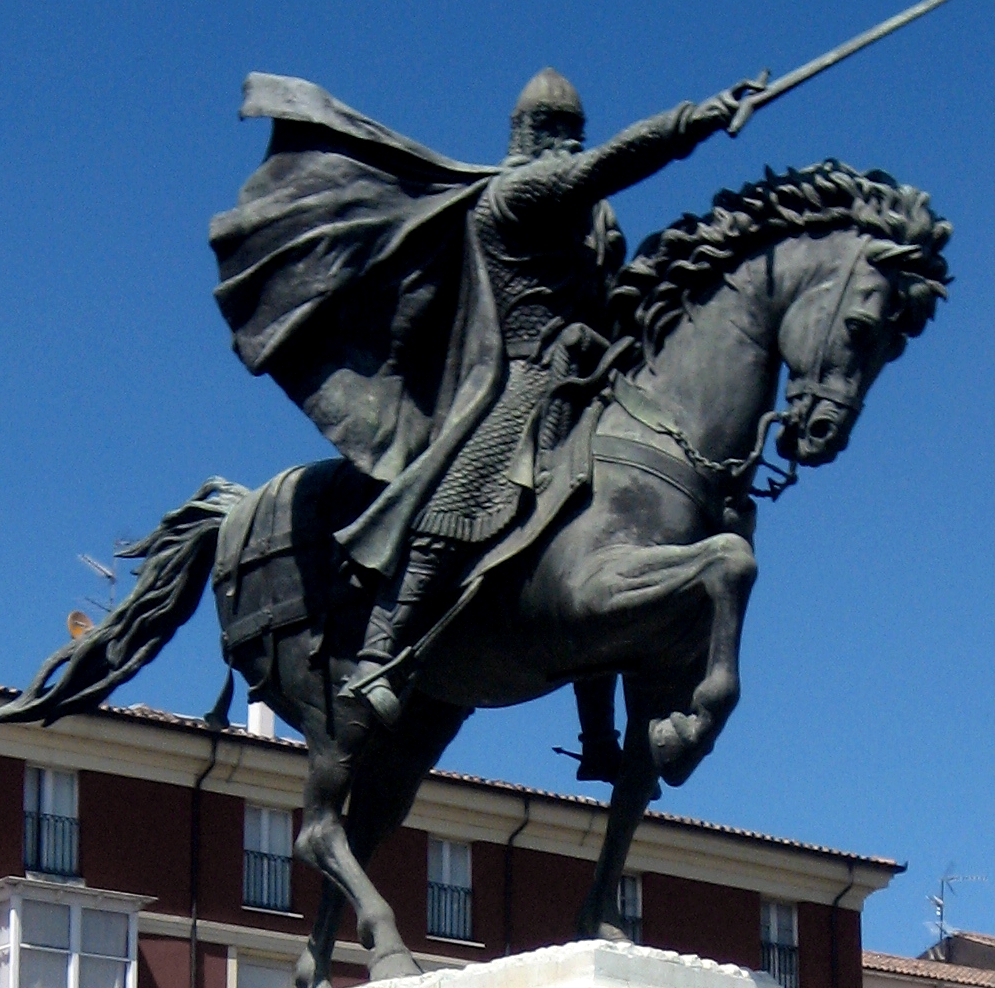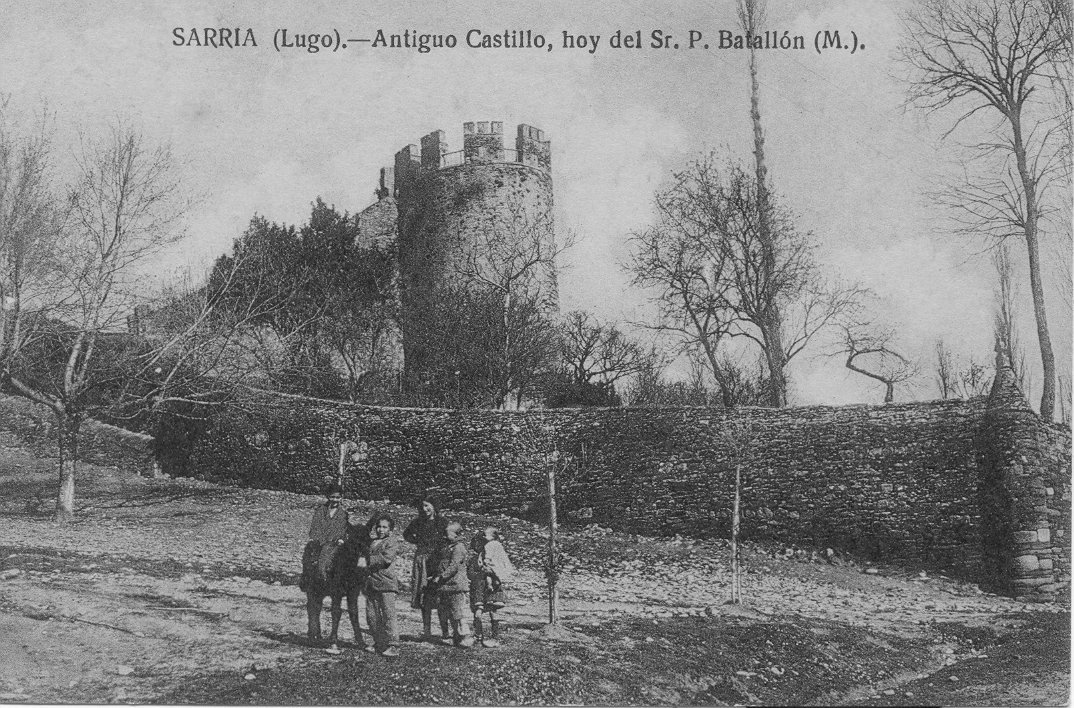|
Vela Ovéquiz
Vela Ovéquiz or Ovéquez (died after June 1085) was a count in the Kingdom of Galicia during the reigns of García II (1065–71) and Alfonso VI (1071–1109). He and his family owned properties around Lugo, which controlled the entrance to Galicia from western Asturias, where he was also a landholder. He was married to Aldonza Muñoz, daughter of Count Muño Fernández and Elvira. They had a son, Rodrigo Vélaz, who was also a count. On 28 February 1068, during the reign of García, Count Vela witnessed a royal charter issued to the monastery of San Antolín de Toques on the occasion of the consecration of Bishop Gudesteus of Iria Flavia. In the fall of 1071, after Alfonso VI had conquered the kingdom, Vela and his brothers Rodrigo and Bermudo attended his court and appear as counts and witnesses in several charters of the new king of Galicia. Vela may have been killed in the great defeat at Zalaca on 23 October 1086. There is no full record of those slain in the battle, but ... [...More Info...] [...Related Items...] OR: [Wikipedia] [Google] [Baidu] |
Kingdom Of Galicia
The Kingdom of Galicia ( gl, Reino de Galicia, or ''Galiza''; es, Reino de Galicia; pt, Reino da Galiza; la, Galliciense Regnum) was a political entity located in southwestern Europe, which at its territorial zenith occupied the entire northwest of the Iberian Peninsula. It was founded by the Suebic king Hermeric in 409, with its capital established in Braga. It was the first kingdom that officially adopted Catholicism. In 449, it minted its own currency. In 585, it became a part of the Visigothic Kingdom. In the 8th century, Galicia became a part of the newly founded Christian Kingdom of Asturias, which later became the Kingdom of León, while occasionally achieving independence under the authority of its own kings. Compostela became the capital of Galicia in the 11th century, while the independence of Portugal (1128) determined its southern boundary. The accession of Castilian King Ferdinand III to the Leonese kingdom in 1230 brought Galicia under the control of the C ... [...More Info...] [...Related Items...] OR: [Wikipedia] [Google] [Baidu] |
Rodrigo Ovéquiz
Rodrigo is a Spanish, Portuguese and Italian name derived from the Germanic name ''Roderick'' (Gothic ''*Hroþareiks'', via Latinized ''Rodericus'' or ''Rudericus''), given specifically in reference to either King Roderic (d. 712), the last Visigothic ruler or to Saint Roderick (d. 857), one of the Martyrs of Córdoba (feast day 13 March). The modern given name has the short forms ''Ruy, Rui'', and in Galician ''Roi''. The name is very frequently given in Portugal; it was the most popularly given masculine name in 2011–2012, and during 2013–2016 ranked between 4th and 2nd most popular. It is also moderately popular in Spain, ranking between 30th and 60th most popular during 2002–2015. History The form ''Rodrigo'' becomes current in the later medieval period. It is recorded in the '' Cantar de Mio Cid'', written c. 1200, as the name of Rodrigo Díaz de Vivar (c. 1043–1099, known as ''El Cid Campeador'').v. 467 ('' Destierro del Cid''): ''Mio Çid don Rod ... [...More Info...] [...Related Items...] OR: [Wikipedia] [Google] [Baidu] |
Year Of Birth Unknown
A year or annus is the orbital period of a planetary body, for example, the Earth, moving in its orbit around the Sun. Due to the Earth's axial tilt, the course of a year sees the passing of the seasons, marked by change in weather, the hours of daylight, and, consequently, vegetation and soil fertility. In temperate and subpolar regions around the planet, four seasons are generally recognized: spring, summer, autumn and winter. In tropical and subtropical regions, several geographical sectors do not present defined seasons; but in the seasonal tropics, the annual wet and dry seasons are recognized and tracked. A calendar year is an approximation of the number of days of the Earth's orbital period, as counted in a given calendar. The Gregorian calendar, or modern calendar, presents its calendar year to be either a common year of 365 days or a leap year of 366 days, as do the Julian calendars. For the Gregorian calendar, the average length of the calendar year ( ... [...More Info...] [...Related Items...] OR: [Wikipedia] [Google] [Baidu] |
1080s Deaths
1 (one, unit, unity) is a number representing a single or the only entity. 1 is also a numerical digit and represents a single unit of counting or measurement. For example, a line segment of ''unit length'' is a line segment of length 1. In conventions of sign where zero is considered neither positive nor negative, 1 is the first and smallest positive integer. It is also sometimes considered the first of the infinite sequence of natural numbers, followed by 2, although by other definitions 1 is the second natural number, following 0. The fundamental mathematical property of 1 is to be a multiplicative identity, meaning that any number multiplied by 1 equals the same number. Most if not all properties of 1 can be deduced from this. In advanced mathematics, a multiplicative identity is often denoted 1, even if it is not a number. 1 is by convention not considered a prime number; this was not universally accepted until the mid-20th century. Additionally, 1 is the ... [...More Info...] [...Related Items...] OR: [Wikipedia] [Google] [Baidu] |
Merindad
''Merindad'' () is a Mediaeval Spanish administrative term for a country subdivision smaller than a province but larger than a municipality. The officer in charge of a merindad was called a merino, roughly equivalent to the English ''count'' or ''bailiff''. It was used in the kingdoms of Castile and Navarre. Connected to the birth of Castile, the Merindades, standing for a northernmost ''comarca'' of the province of Burgos, was part of the creation of the administrative division by King Peter. Currently, the Foral Community of Navarre is still divided into five ''merindades'' standing for different judicial districts. The historic ''Merindad de Ultrapuertos'' lying to the north of the Pyrenees is nowadays Lower Navarre. Administratively, they have been substituted by the '' partido judicial''. In Biscay, the ''mancomunidades comarcales'' keep the place of the old ''merindades'', such as Duranguesado. See also * Partidos of Buenos Aires, a second-level administrative subdiv ... [...More Info...] [...Related Items...] OR: [Wikipedia] [Google] [Baidu] |
Battle Of Sagrajas
The Battle of Sagrajas (23 October 1086), also called Zalaca or Zallaqa ( ar, معركة الزلاقة, translit=Maʿrakat az-Zallāqa), was a battle between the Almoravid army led by their King Yusuf ibn Tashfin and an army led by the Castilian King Alfonso VI. The Almoravids responded to the call of Jihad by the taifas which commonly fought amongst themselves however they had united to battle the powerful Christian states to the north. The Taifas aided the Almoravids during the battle with troops, favoring the battle for the Muslim side. The battleground was later called ''az-Zallaqah'' (in English "slippery ground") because of the poor footing caused by the tremendous amount of bloodshed that day, which gave rise to its name in Arabic. Preparations After Alfonso VI, King of León and Castile, captured Toledo in 1085 and invaded the taifa of Zaragoza, the emirs of the smaller taifa kingdoms of Islamic Iberia found that they could not resist him without external assis ... [...More Info...] [...Related Items...] OR: [Wikipedia] [Google] [Baidu] |
Bermudo Ovéquiz
Bermudo Ovéquiz (''fl.'' 1044–1092) (also known as Vermudo) was a member of the highest ranks of the nobility of Asturias, León, and Galicia who lived in the 11th century. Biographical sketch Bermudo Ovéquiz was the first-born son of Oveco Bermúdez and his wife Elvira Suárez. His paternal grandparents were Bermudo Vela—a descendant of Count Bermudo Núñez— and Elvira Pinióliz. His mother was granddaughter of rebel Rodrigo Romániz, nephew of Count Suero Gundemáriz, and she also descended from Osorio Gutiérrez, known as the "holy count". Bermudo lived in Asturias where he probably inherited properties from his grandmother Elvira Pinióliz. He is first recorded in medieval charters in 1045 and appears in 1053 confirming a donation by King Ferdinand I of León to the Monastery of San Pelayo in Oviedo. In 1075, he and his brother Vela Ovéquiz were engaged in a legal dispute with the bishop of Oviedo on account of the Monastery of Tol. This monastery had been ... [...More Info...] [...Related Items...] OR: [Wikipedia] [Google] [Baidu] |
Gudesteus (bishop Of Iria)
Gudesteus ( gl, Gudesteo) was the bishop of Iria Flavia from 1067, when he succeeded his uncle Cresconius, until his assassination in 1069. He was asleep with some of his clerics when the soldiers of "Count Froila Iliam" (perhaps Froila Arias), another of his uncles, murdered him, a crime which the ''Historia compostellana The (fully titled in la, De rebus gestis D. Didaci Gelmirez, primi Compostellani Archiepiscopi) is an anonymously-written historical chronicle based on the relation of events by a writer in the immediate circle of Diego Gelmírez, second bisho ...'' calls "the contrivance and treachery of the princes of Galicia", implicating the entire noble class.Amancio Isla Frez"Ensayo de historiografía medieval: El ''Cronicón Iriense'',"''En la España medieval'', 4 (1984), 421: ''dolo et proditione a Principibus Galleciae''. Notes 1069 deaths Assassinated religious leaders Bishops and archbishops of Iria and Compostela Year of birth unknown 11th-century Roma ... [...More Info...] [...Related Items...] OR: [Wikipedia] [Google] [Baidu] |
García II Of Galicia
García II (1041/April 104322 March 1090), King of Galicia, was the youngest of the three sons and heirs of Ferdinand I, King of Castile and León, and Sancha of León, whose Leonese inheritance included the lands García would be given. Garcia first appears in an 11 September 1064 settlement with Suero, Bishop of Mondoñedo, his father confirming the agreement. Accession In the 1065 division of his father's estates, García was given the County of Galicia, "elevated to the rank of kingdom", that extended south to the Mondego River in Portugal with the ''parias'' of the Taifa of Badajoz and Seville; his eldest brother Sancho received the Kingdom of Castile and the ''parias'' of the Taifa of Zaragoza. The second son and his father's favorite, Alfonso, fared best in this division, being given an expanded Kingdom of León that encroached on lands that historically had been Castilian and Galician. Garcia's Galician kingdom was the most troubled, including lands south of the Duero ... [...More Info...] [...Related Items...] OR: [Wikipedia] [Google] [Baidu] |
San Antolín De Toques
Igrexa de San Antolín de Toques is a church in Toques, Spain, Toques, Province of A Coruña, Galicia (Spain), Galicia, Spain. It was founded in the 10th century. References Churches in Galicia (Spain) Buildings and structures in the Province of A Coruña 10th-century churches in Spain Bien de Interés Cultural landmarks in the Province of A Coruña {{Spain-church-stub ... [...More Info...] [...Related Items...] OR: [Wikipedia] [Google] [Baidu] |
Rodrigo Vélaz
Rodrigo Vélaz (died June 1144) was the "count of Galicia, who held Sarria" according to the near-contemporary '' Chronica Adefonsi imperatoris''. During his long public career he was the dominant figure in mountainous eastern Galicia while the House of Traba dominated its western seaboard. He served under three monarchs—Alfonso VI, Urraca, and Alfonso VII—and was loyal to all of them, never figuring in any rebellion. The contemporary ''Historia compostellana'' is a valuable source for his life, since there are no aristocratic archives surviving in Spain from this period. Rodrigo's career must be pieced together from the few references in the chronicles and the (copies of) charters preserved in various ecclesiastical archives.Barton (1997), 2. He was a son of Count Vela Ovéquiz and Aldonza Muñoz, daughter of Count Muño Fernández and Elvira.Barton (1997), 299. Rodrigo married Urraca Álvarez, daughter of Álvar Fáñez and Mayor Pérez, a daughter of Pedro Ansúrez. Rodrig ... [...More Info...] [...Related Items...] OR: [Wikipedia] [Google] [Baidu] |





